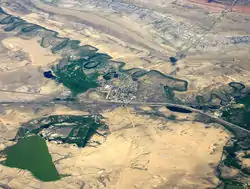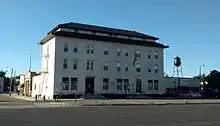Medicine Bow, Wyoming | |
|---|---|
 Aerial view of Medicine Bow and surrounding area | |
 Location of Medicine Bow in Carbon County, Wyoming | |
 Medicine Bow, Wyoming Location in the United States | |
| Coordinates: 41°53′52″N 106°12′10″W / 41.89778°N 106.20278°W | |
| Country | United States |
| State | Wyoming |
| County | Carbon |
| Area | |
| • Total | 3.46 sq mi (8.96 km2) |
| • Land | 3.46 sq mi (8.96 km2) |
| • Water | 0.00 sq mi (0.00 km2) |
| Elevation | 6,565 ft (2,001 m) |
| Population | |
| • Total | 284 |
| • Estimate (2019)[3] | 259 |
| • Density | 74.90/sq mi (28.92/km2) |
| Time zone | UTC-7 (Mountain (MST)) |
| • Summer (DST) | UTC-6 (MDT) |
| ZIP code | 82329 |
| Area code | 307 |
| FIPS code | 56-51575[4] |
| GNIS feature ID | 1591446[5] |
| Website | www |
Medicine Bow is a town in Carbon County, Wyoming, United States. Its population was 284 at the 2010 census.
History

The community largely owes its existence to the first transcontinental railroad, built through the area in 1868. A post office called Medicine Bow has been in operation since 1869.[6] The community was named after the Medicine Bow River.[7]
Dippy, a well-known dinosaur skeleton, was found in a quarry nearby around 1898. In 1899, fossil hunters for the American Museum of Natural History and the Field Museum stayed in or near the town during their search for large dinosaur skeletons.[8] The town had a railroad and was near the fossilferous sedimentary hills from the Jurassic Morrison Formation, making it an important stopping location for paleontologists, with fossils of Diplodocus and Brontosaurus found nearby at Como Bluff by the two institutions during the late 19th and early 20th centuries.[8]
The town was noted to be plagued by crime, with famous bandits such as Butch Cassidy and his Wild Bunch enacting the Wilcox Train Robbery only a few miles away from the AMNH’s fossil localities and Medicine Bow itself.[9][8]
The Virginian Hotel is a historic hotel located in Medicine Bow. It was built in 1911 by August Grimm. The hotel was added to the National Register of Historic Places in 1978.[10]
In the 1910s, part of the Lincoln Highway was routed through Medicine Bow until Interstate 80 replaced it in 1970.
Geography
Medicine Bow is located at 41°53′52″N 106°12′10″W / 41.89778°N 106.20278°W (41.897668, -106.202796).[11]
According to the United States Census Bureau, the town has a total area of 3.46 square miles (8.96 km2), all land.[12]
Climate
| Climate data for Medicine Bow, Wyoming (1991–2020 normals, extremes 1948–present) | |||||||||||||
|---|---|---|---|---|---|---|---|---|---|---|---|---|---|
| Month | Jan | Feb | Mar | Apr | May | Jun | Jul | Aug | Sep | Oct | Nov | Dec | Year |
| Record high °F (°C) | 58 (14) |
61 (16) |
73 (23) |
80 (27) |
90 (32) |
96 (36) |
97 (36) |
96 (36) |
92 (33) |
81 (27) |
71 (22) |
57 (14) |
97 (36) |
| Mean maximum °F (°C) | 47.6 (8.7) |
50.7 (10.4) |
61.9 (16.6) |
72.3 (22.4) |
80.2 (26.8) |
88.2 (31.2) |
92.5 (33.6) |
89.6 (32.0) |
83.8 (28.8) |
74.5 (23.6) |
60.2 (15.7) |
48.0 (8.9) |
91.6 (33.1) |
| Mean daily maximum °F (°C) | 31.3 (−0.4) |
34.8 (1.6) |
45.6 (7.6) |
55.1 (12.8) |
64.8 (18.2) |
77.4 (25.2) |
85.3 (29.6) |
83.0 (28.3) |
73.6 (23.1) |
59.1 (15.1) |
42.8 (6.0) |
32.8 (0.4) |
57.1 (13.9) |
| Daily mean °F (°C) | 20.8 (−6.2) |
23.1 (−4.9) |
31.9 (−0.1) |
40.0 (4.4) |
49.1 (9.5) |
60.0 (15.6) |
66.8 (19.3) |
64.4 (18.0) |
55.0 (12.8) |
42.9 (6.1) |
30.2 (−1.0) |
21.7 (−5.7) |
42.2 (5.7) |
| Mean daily minimum °F (°C) | 10.3 (−12.1) |
11.5 (−11.4) |
18.1 (−7.7) |
25.0 (−3.9) |
33.3 (0.7) |
42.6 (5.9) |
48.3 (9.1) |
45.9 (7.7) |
36.3 (2.4) |
26.7 (−2.9) |
17.6 (−8.0) |
10.7 (−11.8) |
27.2 (−2.7) |
| Mean minimum °F (°C) | −13.7 (−25.4) |
−14.0 (−25.6) |
−2.3 (−19.1) |
12.2 (−11.0) |
22.2 (−5.4) |
32.0 (0.0) |
38.8 (3.8) |
36.3 (2.4) |
24.2 (−4.3) |
11.3 (−11.5) |
−4.5 (−20.3) |
−13.0 (−25.0) |
−25.1 (−31.7) |
| Record low °F (°C) | −46 (−43) |
−44 (−42) |
−22 (−30) |
−10 (−23) |
12 (−11) |
23 (−5) |
27 (−3) |
27 (−3) |
13 (−11) |
−13 (−25) |
−27 (−33) |
−44 (−42) |
−46 (−43) |
| Average precipitation inches (mm) | 0.41 (10) |
0.63 (16) |
0.72 (18) |
1.38 (35) |
1.74 (44) |
1.38 (35) |
1.11 (28) |
0.82 (21) |
0.96 (24) |
1.01 (26) |
0.55 (14) |
0.49 (12) |
11.20 (284) |
| Average snowfall inches (cm) | 6.5 (17) |
7.9 (20) |
7.6 (19) |
7.3 (19) |
2.4 (6.1) |
0.0 (0.0) |
0.0 (0.0) |
0.0 (0.0) |
1.2 (3.0) |
5.5 (14) |
6.5 (17) |
6.8 (17) |
51.7 (131) |
| Average precipitation days (≥ 0.01 in) | 6.2 | 6.1 | 5.8 | 8.1 | 9.8 | 7.6 | 7.0 | 7.5 | 6.8 | 6.8 | 6.2 | 6.6 | 84.5 |
| Average snowy days (≥ 0.1 in) | 5.2 | 5.8 | 4.3 | 3.5 | 1.0 | 0.0 | 0.0 | 0.0 | 0.4 | 2.0 | 4.5 | 5.3 | 32.0 |
| Source: NOAA (mean maxima/minima 1981–2010)[13][14] | |||||||||||||
Demographics
| Census | Pop. | Note | %± |
|---|---|---|---|
| 1910 | 127 | — | |
| 1920 | 210 | 65.4% | |
| 1930 | 264 | 25.7% | |
| 1940 | 338 | 28.0% | |
| 1950 | 328 | −3.0% | |
| 1960 | 392 | 19.5% | |
| 1970 | 455 | 16.1% | |
| 1980 | 953 | 109.5% | |
| 1990 | 389 | −59.2% | |
| 2000 | 274 | −29.6% | |
| 2010 | 284 | 3.6% | |
| 2019 (est.) | 259 | [3] | −8.8% |
| U.S. Decennial Census[15] | |||
As of 2000, the median income for a household in the town was $33,750, and for a family was $35,156. Males had a median income of $41,250 versus $20,536 for females. The per capita income for the town was $16,420. About 10.3% of families and 11.9% of the population were below the poverty line, including 9.2% of those under the age of eighteen and 17.5% of those 65 or over.
2010 census
As of the census[2] of 2010, 284 people, 125 households, and 81 families resided in the town. The population density was 82.1 inhabitants per square mile (31.7/km2). The 182 housing units had an average density of 52.6 per square mile (20.3/km2). The racial makeup of the town was 95.1% White, 0.4% Pacific Islander, 3.9% from other races, and 0.7% from two or more races. Hispanics or Latinos of any race were 6.7% of the population.
Of the 125 households, 20.8% had children under 18 living with them, 50.4% were married couples living together, 7.2% had a female householder with no husband present, 7.2% had a male householder with no wife present, and 35.2% were not families. About 29.6% of all households were made up of individuals, and 18.4% had someone living alone who was 65 or older. The average household size was 2.27, and the average family size was 2.79.
The median age in the town was 49.3 years; 20.1% of residents were under 18; 3.5% were between 18 and 24; 21.1% were from 25 to 44; 29.9% were from 45 to 64; and 25.4% were 65 or older. The gender makeup of the town was 53.5% male and 46.5% female.
Economy
In December 2007, plans were announced for construction of a large coal gasification plant to be built southwest of town.[16] The plant was expected to start construction in 2014.[17] In 2014, DKRW Advanced Fuels terminated their contract with Sinopec, the Chinese firm that would have built the plant.[17] In 2015, there were plans to downscale the plant,[18] and in 2016, the project was put on indefinite hold, partly due to the low cost of crude oil in the US.[19]
Education
Public education in the town of Medicine Bow is provided by Carbon County School District Number 2. Zoned campuses include Medicine Bow Elementary School (grades K–6) and H.E.M. Junior/Senior High School (grades 7–12).
Medicine Bow has a public library, a branch of the Carbon County Library System.[20]
In popular culture
Much of the Western novel The Virginian and subsequent television series of the same name were set in or near Medicine Bow.
Chapter XXVIII from Jules Verne's Around the World in Eighty Days involves a subplot about making a train pass through an unsafe bridge near Medicine Bow.
In the 1960 episode of the television series Maverick entitled "The Misfortune Teller", hero Bret Maverick is nearly lynched by the citizens of Medicine Bow, under the mistaken impression that he is a swindler and the murderer of their late mayor.
See also
References
- ↑ "2019 U.S. Gazetteer Files". United States Census Bureau. Retrieved August 7, 2020.
- 1 2 "U.S. Census website". United States Census Bureau. Retrieved December 14, 2012.
- 1 2 "Population and Housing Unit Estimates". United States Census Bureau. May 24, 2020. Retrieved May 27, 2020.
- ↑ "U.S. Census website". United States Census Bureau. Retrieved January 31, 2008.
- ↑ "US Board on Geographic Names". United States Geological Survey. October 25, 2007. Retrieved January 31, 2008.
- ↑ "Post Offices". Jim Forte Postal History. Retrieved January 5, 2017.
- ↑ Moyer, Armond; Moyer, Winifred (1958). The origins of unusual place-names. Keystone Pub. Associates. p. 83.
- 1 2 3 Brinkman, P. D. (2010). The second Jurassic dinosaur rush. In The Second Jurassic Dinosaur Rush. University of Chicago Press.
- ↑ "The Wilcox Holdup". The Pittsburgh Press. September 29, 1905. Retrieved 4 February2013.
- ↑ "National Register Information System". National Register of Historic Places. National Park Service. April 15, 2008.
- ↑ "US Gazetteer files: 2010, 2000, and 1990". United States Census Bureau. February 12, 2011. Retrieved April 23, 2011.
- ↑ "US Gazetteer files 2010". United States Census Bureau. Archived from the original on January 25, 2012. Retrieved December 14, 2012.
- ↑ "NOWData - NOAA Online Weather Data". National Oceanic and Atmospheric Administration. Retrieved December 10, 2021.
- ↑ "Station: Medicine Bow, WY". U.S. Climate Normals 2020: U.S. Monthly Climate Normals (1991-2020). National Oceanic and Atmospheric Administration. Retrieved December 10, 2021.
- ↑ "Census of Population and Housing". Census.gov. Retrieved June 4, 2015.
- ↑ "SIERRA CLUB v. WYOMING DEPARTMENT OF ENVIRONMENTAL QUALITY, and MEDICINE BOW FUEL & POWER, LLC". Justia Law. Retrieved January 23, 2019.
- 1 2 "DKRW to start construction of Medicine Bow plant in one year". www.wyomingsbdc.org. July 1, 2013. Retrieved February 3, 2017.
- ↑ Benjamin.Storrow@trib.com, Benjamin Storrow 307-335-5344 (June 25, 2015). "DKRW considers downsizing proposed coal gasification plant, residents doubtful". Casper Star-Tribune Online. Retrieved February 3, 2017.
{{cite news}}: CS1 maint: numeric names: authors list (link) - ↑ "Wyoming plans for DKRW coal-to-liquid plant stall". The Billings Gazette. Associated Press. January 7, 2016. Retrieved February 3, 2017.
- ↑ "Wyoming Public Libraries". PublicLibraries.com. Retrieved June 13, 2019.
Further reading
- Barrett, Glen. (1978) The Virginian at Medicine Bow.
- Roberts, David L. (1991) Sage Street: A Collection of Stories.
